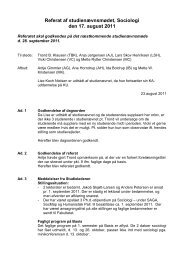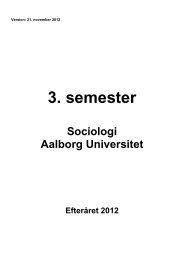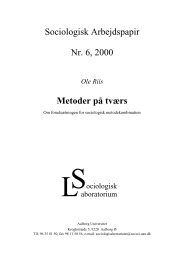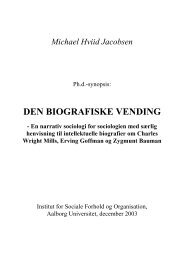Utopianism in the Work of Zygmunt Bauman - Sociologi - Aalborg ...
Utopianism in the Work of Zygmunt Bauman - Sociologi - Aalborg ...
Utopianism in the Work of Zygmunt Bauman - Sociologi - Aalborg ...
You also want an ePaper? Increase the reach of your titles
YUMPU automatically turns print PDFs into web optimized ePapers that Google loves.
tised. Utopias have, however, not been entirely dissolved but thoroughly trans-<br />
formed. Present day versions <strong>of</strong> utopia are nowadays as a consequence perhaps<br />
best described with <strong>the</strong> apt term co<strong>in</strong>ed by Michel Foucault (1986) ‘heteroto-<br />
pias’ which are not non-places but are places out <strong>of</strong> place, as it were, ‘counter-<br />
sites’ and places where <strong>the</strong> waste-products <strong>of</strong> civilisation and especially mod-<br />
ern utopian civilisation are cast. Heterotopias are thus both part and parcel <strong>of</strong><br />
and <strong>in</strong>dispensable to utopias as well as <strong>the</strong>ir distorted materialisation. They are<br />
also alternative places designated to <strong>the</strong> outskirts or normalcy or <strong>the</strong> dom<strong>in</strong>ant<br />
way <strong>of</strong> life. Toge<strong>the</strong>r with <strong>the</strong> rise <strong>of</strong> such heterotopias, also what John O’Neill<br />
(1993) with a colourful metaphor termed ‘McTopia’ where time is eaten away<br />
<strong>in</strong>stead <strong>of</strong> as <strong>in</strong> real utopias be<strong>in</strong>g constant or eternal, appears as a sign <strong>of</strong> <strong>the</strong><br />
times. To many, both heterotopias and McTopias are expressions <strong>of</strong> <strong>the</strong> so-<br />
called dystopias or anti-topias.<br />
The divid<strong>in</strong>g l<strong>in</strong>e between utopias, dystopias and heterotopias is one <strong>in</strong>ti-<br />
mately dependent upon def<strong>in</strong>ition. <strong>Bauman</strong>’s images <strong>of</strong> modernity and post-<br />
modernity or liquid modernity can and with good reason <strong>of</strong>ten been regarded as<br />
heterotopias but equally as dystopias – <strong>the</strong> mirror opposite <strong>of</strong> utopias. Every-<br />
th<strong>in</strong>g beautiful can decompose <strong>in</strong>to ugl<strong>in</strong>ess, everyth<strong>in</strong>g <strong>in</strong>tended to liberate<br />
people may lead to terror and totalitarianism, everyth<strong>in</strong>g thought <strong>of</strong> as <strong>the</strong> good<br />
society may turn out bad and sour. This is perhaps an imm<strong>in</strong>ent aspect <strong>of</strong> <strong>the</strong><br />
critical <strong>the</strong>oretically oriented strand <strong>of</strong> his sociology, which also conta<strong>in</strong>s a<br />
more literary strand. In style, substance and artistic effects, his work is equally<br />
rem<strong>in</strong>iscent <strong>of</strong> many literary expositions and poetic descriptions <strong>of</strong> how <strong>the</strong><br />
world could be imag<strong>in</strong>ed and constructed if we discard <strong>the</strong> one-dimensionality<br />
<strong>of</strong> many modernist utopian visions and also rem<strong>in</strong>iscent <strong>of</strong> how literary writers<br />
depict <strong>the</strong> world as hav<strong>in</strong>g taken <strong>the</strong> wrong turn towards utopia and <strong>in</strong>stead<br />
ended <strong>in</strong> <strong>the</strong> doldrums. This literary imag<strong>in</strong>ation, naturally coupled with a so-<br />
ciological imag<strong>in</strong>ation <strong>in</strong> his work, may assist as an alternative utopian strand<br />
27










